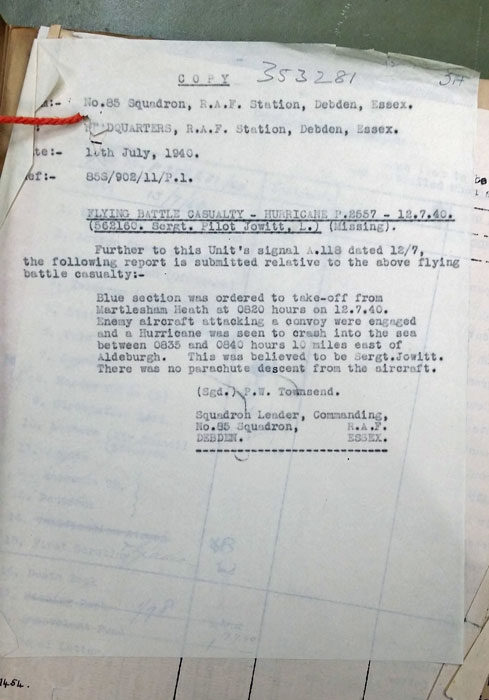The Airmen's Stories - Sgt. L Jowitt
Leonard Jowitt was born in Failsworth, Manchester on 22nd July 1911, the son of Leonard and Emily Jane Jowitt.
He was educated at Oulton Secondary School, Liverpool. After briefly working as a clerk he joined the RAF on 10th January 1928 as an Aircraft Apprentice at No. 1 School of Technical Training, Halton.
In December 1931 Jowitt passed out as a Fitter Airframes/Engines and from 23rd January 1932 to 30th March 1934 he served with 20 (Army Co-Operation) Squadron in India. The squadron was involved in policing the North-West Frontier between the wars. Jowitt received the Mohmand Clasp to the India General Service Medal.

Back in the UK Jowitt applied for pilot training. On 10th April 1937 he was recommended by the AOC for training as an Airman Pilot. He went to 6 FTS Netheravon on No. 8 Course on 22nd January 1938, was promoted to Corporal on 1st July and passed out as a Sergeant-Pilot on 20th August 1938 joining the recently-reformed 85 Squadron at Debden.

The squadron flew to France on 9th September 1939. Jowitt was one of several pilots who took off to intercept He111s attacking 85 squadron's airfield at Lille-Seclin on 15th May 1940. At 7,000 feet he attacked a bomber which had broken away from its formation. It caught fire and he followed it down to see it crash and explode in the fork of a railway junction half a mile south of Templeure.
The squadron was withdrawn to Debden on 21st May, returning with only three Hurricanes.

(Above: Jowitt appears third from right with fellow 85 Squadron pilots, his head shaved as a penalty for losing a bet)
It was reformed and re-equipped on 10th July 1940. Two days later Jowitt was one of a section of three aircraft dispatched to protect convoy Booty from attack by He111s. He was shot down and crashed into the sea off Felixstowe and was not seen again.

Postwar Townsend recorded:
He was a good pilot and had already gained combat experience in France. He was popular and something of a joker. With another pilot, Patrick Woods-Scawen, he had an act which made us all laugh. I vaguely recall that it was the presentation of a medal by a French general accompanied with the usual gesticulations and ending with the accolade (a kiss on each cheek).
Jowitt is remembered on the Runnymede Memorial, Panel 16.

(Above image courtesy of Dean Sumner).
|